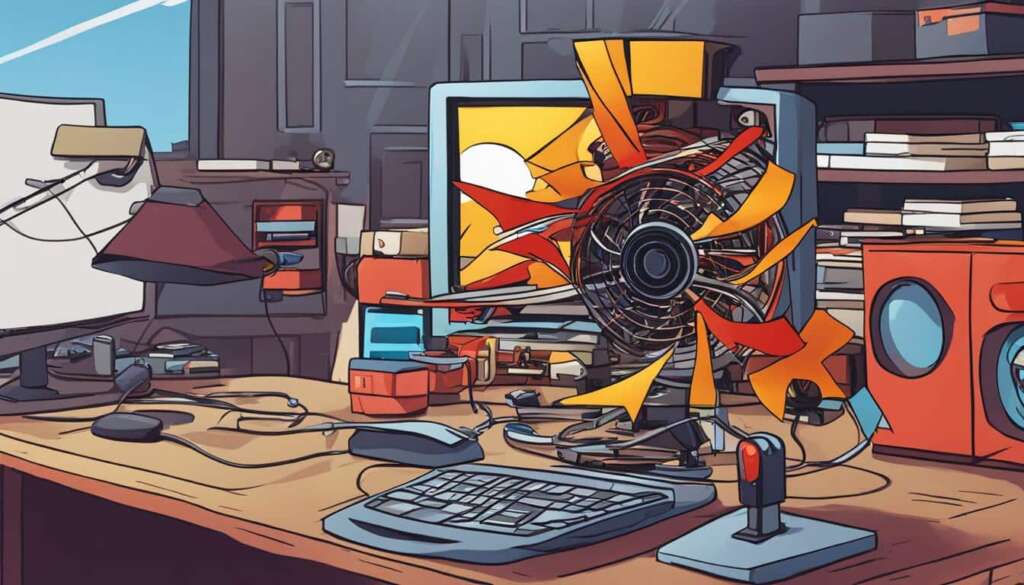Table of Contents
One of the main reasons a PC overheats is internal fans not operating at required speeds. This is often due to the automatic fan controller not functioning correctly. Luckily, you can adjust your fan speeds manually using a few different methods. Manually adjusting your fan speed is also an essential step in overclocking a CPU. This guide covers how to manually adjust your CPU fan as well as any other case fans.
Is your PC overheating and causing performance issues? Don’t fret! By learning how to adjust the fan speed on your PC, you can effectively manage the cooling system and ensure optimal performance for your computer. In this quick guide, we’ll walk you through the process of manually adjusting your fan speeds and avoiding the headache of an overheating PC.
When your PC fan speeds are not operating at the required levels, it can lead to overheating. This can negatively impact the overall performance of your computer and even lead to irreversible damage to critical components such as the CPU. The automatic fan controller may sometimes fail to regulate the fan speeds effectively, necessitating manual adjustment.
There are multiple methods to manually adjust your fan speed, depending on the type of CPU fan you have installed in your system. We’ll cover everything you need to know about determining the type of CPU fan and the various ways to adjust its speed.
Determining the Type of CPU Fan
Before making any adjustments to your CPU fan, it is important to determine its type. There are three main types of CPU fans: Molex fans, PWM fans, and DC fans. Each type has its own characteristics and compatibility requirements.
Molex Fans
Molex fans are the most basic type of CPU fan. They connect directly to the power supply unit (PSU) using a Molex connector. These fans operate at a fixed speed and are not controllable. They are typically found in older systems or budget builds where precise fan control is not necessary. Molex fans are easy to identify by their connector, which features four large pins.
PWM Fans
Pulse Width Modulation (PWM) fans are the most common type of CPU fan in modern systems. These fans use a 4-pin connector and are controlled by varying the voltage supplied to them. This allows for precise control over fan speed. PWM fans are compatible with most motherboards and can be controlled through the BIOS or software utilities.
DC Fans
Direct Current (DC) fans are another type of CPU fan that uses a 3-pin connector. Unlike PWM fans, DC fans are controlled by adjusting the voltage supplied to them. However, DC fans do not offer the same level of control as PWM fans. They can only be adjusted to a few predetermined speed levels. These fans are typically found in older systems or budget builds.
When checking the type of CPU fan you have, look for the number of pins on the connector:
- If your fan has a 4-pin connector, it is likely a PWM fan.
- If your fan has a 3-pin connector, it is likely a DC fan.
- If your fan has a Molex connector, it is a Molex fan.
Knowing the type of CPU fan you have is crucial when adjusting fan speeds. Different fan types require different methods of control, so it’s important to identify the correct type before making any changes.
Adjusting Fan Speed Using UEFI or Software
When it comes to adjusting the fan speed on your PC, you have two main options: utilizing the UEFI (Unified Extensible Firmware Interface) or using software. Both methods offer effective ways to control and fine-tune the fan speeds to achieve optimal cooling.
UEFI Fan Control
The UEFI is a firmware interface that allows you to customize and adjust various settings on your computer, including fan speed control. Adjusting fan speed through UEFI provides a reliable and hardware-level approach to managing cooling performance.
To adjust fan speed through UEFI, you’ll need to access your computer’s BIOS settings. Restart your PC and press the appropriate key (usually Del, F2, or F10) to enter the BIOS setup. Once inside the BIOS, navigate to the “Hardware Monitoring” or “Fan Control” section, where you can adjust fan curves, set fan profiles, and modify speed settings for individual fans.
Keep in mind that the UEFI fan control option may vary depending on your motherboard manufacturer and BIOS version. Refer to your motherboard’s manual or manufacturer’s website for specific instructions on adjusting fan speed using UEFI.
Software Fan Control
If you prefer a more user-friendly approach or you are unable to access UEFI settings, software fan control is an excellent alternative. There are several software utilities available that allow you to adjust fan speed and monitor temperatures in real-time.
One popular software for fan control is SpeedFan. SpeedFan is a lightweight utility that offers the ability to adjust fan speeds based on temperature readings. It also provides detailed system information and monitors various hardware components.
Another option is Argus Monitor, which offers comprehensive fan control capabilities along with temperature monitoring and system health analysis. Argus Monitor allows you to create custom fan curves and profiles to suit your specific cooling needs.
If you’re looking for an all-in-one solution, consider a hardware fan controller like the Commander Pro from Corsair. The Commander Pro offers precise fan speed control, temperature monitoring, and RGB lighting customization, all through a convenient software interface.
Expert Tip:
When adjusting fan speed, it’s important to strike a balance between cooling performance and noise levels. Higher fan speeds can provide better cooling but may generate more noise. Experiment with different fan profiles and curves to find the optimal balance for your system.
Adjusting fan speed using either UEFI or software provides you with the flexibility and control to optimize your PC’s cooling performance. Whether you prefer the hardware-level approach of UEFI fan control or the convenience of software utilities like SpeedFan or Argus Monitor, finding the right fan speed settings can help maintain lower temperatures and improve overall system stability.
Benchmarking and Monitoring Fan Speed
Once you have adjusted your fan speeds to optimize airflow and maintain optimal system temperature, it is essential to benchmark and monitor them regularly. By doing so, you can ensure proper functionality and prevent any potential issues that may arise due to inadequate cooling.
When benchmarking fan speed, you can assess the performance of your cooling system in real-time and make any necessary adjustments for optimal results. This process involves testing the fan speed under different load conditions to evaluate its effectiveness in maintaining temperature stability.
To monitor fan speed and temperature, you can utilize reliable software tools such as Open Hardware Monitor. This intuitive software provides real-time readings of various system metrics, including fan speed, CPU temperature, GPU temperature, and more. By monitoring these crucial parameters, you can identify any anomalies and take prompt action to prevent overheating and potential system damage.
Regularly benchmarking and monitoring fan speed and temperature not only ensures the longevity of your PC but also helps to optimize its performance. By maintaining an ideal balance between airflow and temperature, you can achieve consistent and reliable performance from your system, even during resource-intensive tasks or gaming sessions.
FAQ
How can I change the fan speed on my PC?
You can adjust the fan speed on your PC manually using a few different methods. You can do this through the UEFI or by using software.
What is one of the main reasons a PC overheats?
One of the main reasons a PC overheats is when the internal fans are not operating at the required speeds. This is often due to the automatic fan controller not functioning correctly.
Why is it important to adjust fan speeds when overclocking a CPU?
Adjusting fan speeds is an essential step in overclocking a CPU. It helps to prevent the CPU from overheating and ensures optimal performance.
How can I determine the type of CPU fan I have?
There are several ways to determine the type of CPU fan you have. You can check if it is a Molex fan, a PWM fan, or a DC fan.
How do I adjust the fan speed using UEFI?
To adjust the fan speed using UEFI, you need to access the UEFI settings on your PC and navigate to the fan control options. From there, you can make the necessary adjustments.
Which software can I use to adjust the fan speed on my PC?
There are several software options available to adjust the fan speed on your PC, such as SpeedFan, Fan Control, Argus Monitor, and Commander Pro.
Why is it important to benchmark and monitor fan speeds?
Benchmarking and monitoring fan speeds is important to ensure that the adjustments you made are working properly and that your PC is operating at optimal conditions. It also allows you to keep track of the temperatures and performance of your system.
How can I benchmark and monitor fan speed?
You can benchmark and monitor fan speed by using software like Open Hardware Monitor. This software provides real-time data on temperature, fan speed, and other performance metrics.













